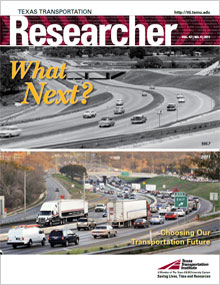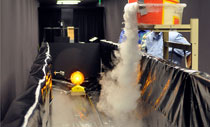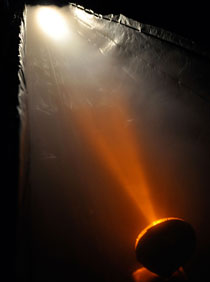When you’re driving, you have to see to be safe. From speed limits to where the roadway curves, traffic signs and pavement markings communicate critical information to help drivers get safely where they’re going. But if the signs and markings aren’t visible, they might as well not be there at all. And at night, “invisible” signs can be particularly dangerous.
Retroreflectivity refers to the ability of a traffic sign to reflect light back to a driver. The Federal Highway Administration (FHWA) has established minimum sign retroreflectivity, and these standards are being phased in over time. FHWA has also started rule making to add minimum pavement marking retroreflectivity requirements to a future edition of its Manual on Uniform Traffic Control Devices. As a result, the Texas Transportation Institute’s (TTI’s) Visibility Research Laboratory — the only one of its kind in the nation — is quickly becoming the go-to facility for testing how well signs and pavement markings maintain their “sight value” as agencies strive to meet the new standard.
Brightening the Night in Alaska
Keeping drivers safe during winter is a challenge for the Alaska Department of Transportation and Public Facilities (Alaska DOT&PF). In northern climates, where winter maintenance activities such as snow plowing are frequent, retroreflectivity becomes difficult to maintain for road-striping crews.
“Many northern states are concerned about FHWA’s pending minimum pavement marking standards,” explains Paul Carlson, head of TTI’s Traffic Operations and Roadway Safety Division. “Alaska was proactive in approaching us about helping them figure out if the proposed standards are reasonable for their unique conditions.”
TTI recently completed a project for Alaska DOT&PF to determine the visibility of in-service pavement markings along lighted and unlighted highway sections. Researchers compared the visibility of in-service pavement markings to FHWA’s proposed minimum pavement marking retroreflectivity levels.
The project team custom-built a specialized piece of data collection equipment consisting of an industrial-quality hand truck, a regulated switching power supply, a global-positioning system receiver, a photometrically calibrated light source, a laptop computer and a charged couple device photometer.
“We used the Visibility Research Laboratory to design and calibrate the equipment,” says Carlson. “If we didn’t have this facility, it would’ve been almost impossible to build the testing equipment.”
The test sites measured were in compliance with the FHWA proposal for minimum pavement marking retroreflectivity levels.
“We now know that our areas with continuous roadway lighting have more than adequate visibility through contrast and reflectivity provided by highway lighting, despite having low retroreflectivity levels,” says Alaska DOT&PF Central Region Traffic Engineer Scott Thomas.
An American Challenge, a Spanish Solution
Carlson and his team also recently completed testing an automated, mobile sign retroreflectivity measurement system carried onboard an instrumented vehicle. The technology is currently used to measure the visibility of traffic signs in Europe. Spain’s Center for Automotive Research and Development, in cooperation with DBi Services of Hazelton, Penn., has developed the van-mounted technology for testing U.S. road signs.
“Measuring sign retroreflectivity from a moving vehicle has some advantages that you just don’t get from handheld devices,” states Carlson, “not the least of which is the inherent reality testing you get assessing retroreflectivity from, literally, the driver’s seat.”
However, measuring retroreflectivity from a moving vehicle can produce slightly different results when compared to standing at the sign and using a handheld device. Handheld devices are built to specific, standard geometries that can be inconsistent with actual roadway design and sign positioning. Measuring retroreflectivity from a moving vehicle provides the actual geometries that are defined by the roadway and sign position.
In the open-road testing, for example, over 100 signs were evaluated with handheld retroreflectometers and mobile testing. The results showed that in most cases, non-contact measurement equipment — mounted on vehicles, for example — will produce slightly lower results than handheld measurement devices. However, the repeatability of the mobile measurements was within the range of repeatability for the handheld devices.
“The lower mobile measurements actually show the system is probably functioning as it should,” says Carlson. “The mobile measurements are more representative of the nighttime drivers’ experience.”
TTI’s findings also suggest that FHWA should consider establishing minimum luminance (or brightness) values to more accurately assess how visible a sign really is to a nighttime driver. While retroreflectivity values are based on luminance, they also depend on certain assumptions about sign placement and roadway design that might or might not be true outside a textbook.
“TTI was integral to helping us evaluate this technology for application in the United States,” says Louis Fuselier of DBi Services. “We couldn’t have done it without them.”
Helping Drivers See Through the Fog
Protecting workers and drivers in a work zone is challenging, especially when nighttime or weather conditions obscure a driver’s vision. The Florida Department of Transportation (FDOT) currently mandates the installation of warning lights in work zones to raise driver awareness at night. But after implementing other improved delineation technologies, FDOT has tasked TTI with evaluating the continued need for warning lights.
Fog is one of the primary weather challenges to seeing clearly while driving, especially at night. For example, turning on your high beams during foggy conditions can actually decrease visibility as the light reflects back from the condensed water vapor (fog) hanging in the air. Associate Research Engineer LuAnn Theiss and her team are looking at how certain weather conditions and maintenance practices impact the value of warning lights in alerting drivers.
“We’ve all experienced driving through work zones in bad weather and having difficulty seeing where we’re going,” explains Theiss. “Instinctively we as human beings know that the better we can see, the safer we can drive.”
Using the lab’s specialized equipment, researchers are actually creating the foggy conditions drivers experience on the road and then quantifying the impacts of the fog on channelizing devices with and without warning lights. When combined with other data collected on the project, the research should indicate whether the continued use of the warning lights provides a significant benefit to drivers.
“Safety is one of the most important aspects of what we transportation engineers do,” says Stefanie Maxwell, specialty engineer with FDOT’s State Construction Office. “TTI’s work will help us determine if we need to continue using warning lights to help keep drivers and workers safe in work zones.”


